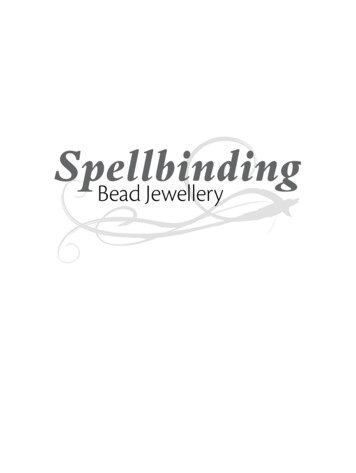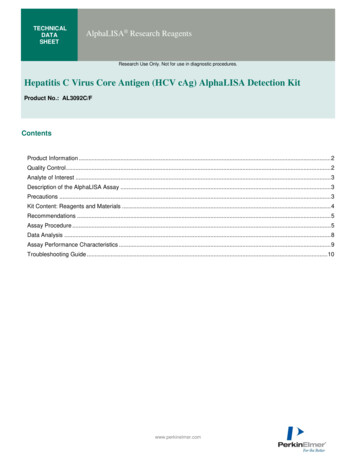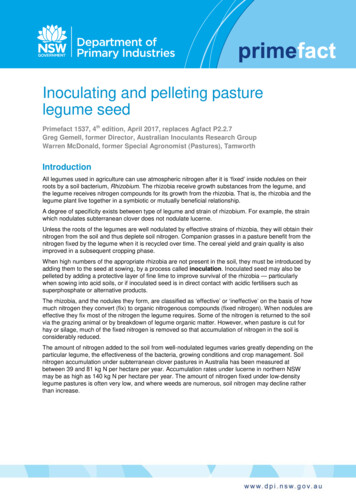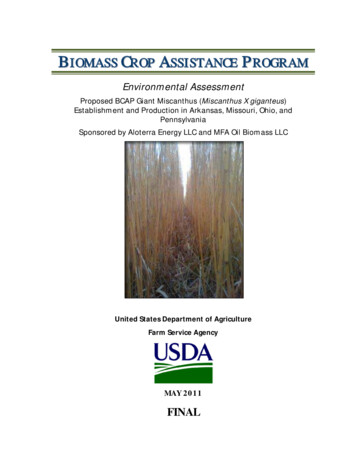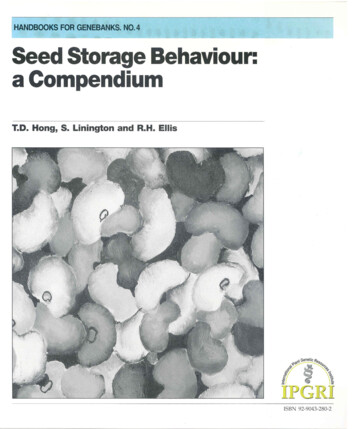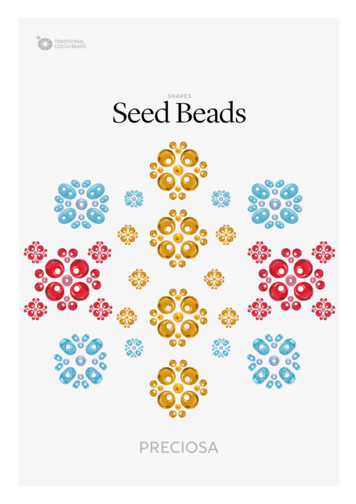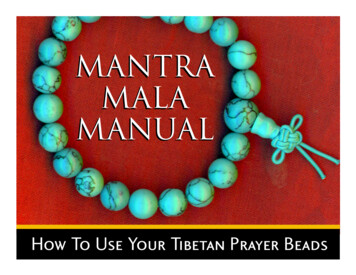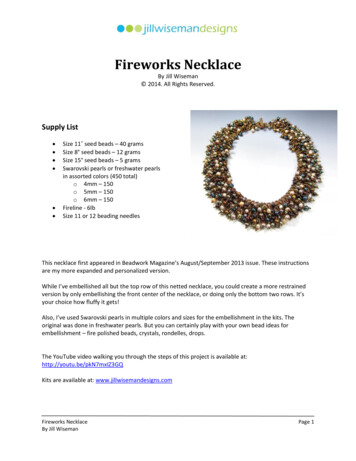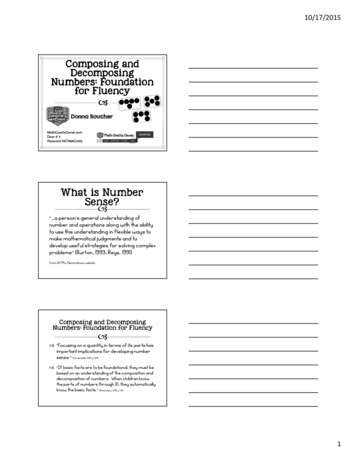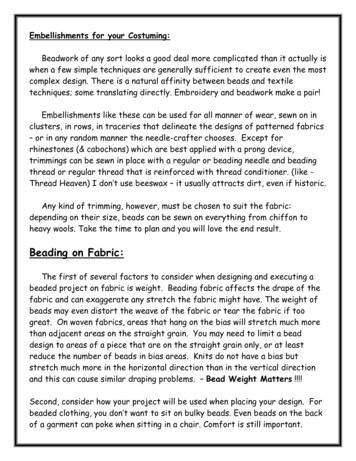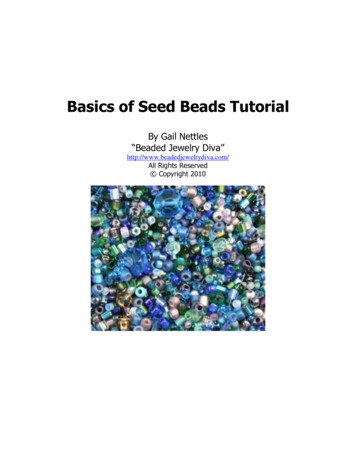
Transcription
Basics of Seed Beads TutorialBy Gail Nettles“Beaded Jewelry Diva”http://www.beadedjewelrydiva.com/All Rights Reserved Copyright 2010
Basics of Seed Beads Free Tutorialhttp://www.beadedjewelrydiva.com/First, the boring stuff:Here’s how you can use this tutorial, Basics of Seed Beads.Since this Basics ebook is free, you can print a copy for your own use, and feel free toshare the ebook with others.All rights are reserved for this ebook and the photos. This means you can’t usethe text or the photos for your own publication without my express written permission.Any questions on this, feel free to email me at gailn@beadedjewelrydiva.com and I’ll domy best to answer you in a timely manner.OK, now that the boring stuff is done, let’s talk about seed beads!Page 1
Basics of Seed Beads Free Tutorialhttp://www.beadedjewelrydiva.com/Welcome to the World of Seed Beads!Seed BeadsBeads, glorious beads! They beckon to us in their tubes, bags and hanks, begging us to bemade into beautiful jewelry.But before you go wild and purchase the whole bead store, or if you are on a tight budget, thenhere are some things to know about seed beads before you get out your pocketbook.Bead SizesHere’s an example of the mostcommon bead sizes that you willcome across; sizes 15 (red), 11(white), 8 (blue) and 6 (black).As you can see from the photo,size 15 is the smallest and size 6is the largest. Each size swatchhas the same number of beads.There are size smaller than 15and larger than 6, but it’s rarethat you will come across themin the course of your beadshopping. And it’s also extremely rare that you’ll see a project that uses these very small andvery large bead sizes.All the beads shown above have what’s called a matte finish, except for the red beads, whichare transparent. (I went looking through my stash for matte size 15 and I couldn’t findany one more bead type I need!). I’ll be discussing bead finishes in just a little bit.Seed beads also come in various shapes. The photo above show the typical “round” seedbeads, but there are cubes, triangles, cylinders, bugles and more. I’ll be showing you examplesof some of the various seed bead shapes.Hmmm, maybe now would be a good time! How about we look at a swatch with differentshapes of seed beads?Page 2
Basics of Seed Beads Free Tutorialhttp://www.beadedjewelrydiva.com/Bead ShapesThere are several bead shapes you need to be aware of, as they can affect the outcome of yourproject. Japanese cylinder beads. Generally these are the Toho and Delica brand beads. Theyare cylinder shapes, with a large hole, and quite regular in size. Though they are small,the larger than normal hole can accommodate multiple thread passes with ease. Themost common sizes available are 8, 11 and 15. Seed beads. These are more donut shaped, and the common shape for the Czechbeads, although you will see them in Japanese beads as well. They can be any size,from 24 through 3, but it’s rare that you will use any sizes outside of 15 through 6. Tube beads. A kind of cross between the cylinder and seed beads. Not as regular asthe cylinders, though.Below are examples of Cylinder, Seed and Tube beads (left to right). They are all size 11. Charlottes. These are usually from the Czech Republic and have a facet cut onto oneside. These are generally in the size 12 to 13 area (although they can be larger orsmaller) and can have a relatively small and/or irregular bead hole. They do shine,though! Below is an example of Charlottes; you can see they are more uneven in sizethan the previous types of beads. These are size 15.Page 3
Basics of Seed Beads Free Tutorialhttp://www.beadedjewelrydiva.com/ Hex cuts. These are tube/cylinder shaped, and have six cuts around the sides, so as tolook like a hexagon. Great for adding texture to a project. Available in most sizes. Triangle. These are what you expect; triangle shaped. These can give a wonderfultexture and look to a project. Most often available in sizes 11, 10 and 8, although youmight occasionally find them in 6 and 15. Cube. These are generally more of a rectangle in shape, and are typically larger thansize 6 beads. Bugle. These are long, thin beads. They canbe straight or twisted, and come in differentlengths. One thing to watch out for is thefact that they generally have sharp beadholes, so you’ll have to either file the beadedges or toss the ones that are really sharp.And make sure to use either a braided threador double your thread just in case. Magatama / Drop. I’ve seen them calledboth, but they are basically teardrop shaped.They are great for embellishment, and aregenerally found in 3mm and 4mm sizes.Here are all of the above; bugles are the gold beadson the left. On the right, top to bottom, are cube,hex, triangle and at the right of the triangles, themagatama / drop beads:And here are yet a few more: Czech duos(upper left), long drops (upper right) andpeanut (middle lower).The bead shapes I’ve listed can be found inmany of the bead finishes discussed on thenext page.Page 4
Basics of Seed Beads Free Tutorialhttp://www.beadedjewelrydiva.com/Bead FinishesThere are a multitude of bead finishes; far more than what I am about to show you in pictures.But here are some of the common ones that you’ll come across.These are matte opaque beads. These areopaque beads that have a frosted surface.These are matte transparent beads. You might alsosee them listed as “frosted”.These are transparent beads; as you cantell, you can see right through them.These are wonderful beads to use it youhave backlighting, but if you don’t, someof the colors will almost look black whenyou use them (like a dark cobalt blue).These beads are actually a bright lemonyellow, but they are slightly muted on thisgray background.Page 5
Basics of Seed Beads Free Tutorialhttp://www.beadedjewelrydiva.com/These are opaque beads. They provide a lot ofcolor, but they don’t tend to have a “glassy” lookto them.These are opaque lustered beads. They have ashiner look than plain opaque beads.Alabaster gilt-lined. These are slightlytranslucent opaque beads and have asilvery undertones.Page 6
Basics of Seed Beads Free Tutorialhttp://www.beadedjewelrydiva.com/These are colorlined beads. This means anopaque core, covered by a transparent color.These beads are turquoise colorlined crystal.These are ceylon finish, which gives the beads apearly look. They can be great when you want apearl effect, but don’t want to use pearls.These are transparent AB. This is atransparent bead with an AB (Aurora Borealis)coating. The AB gives the beads a rainboweffect.Page 7
Basics of Seed Beads Free Tutorialhttp://www.beadedjewelrydiva.com/These are known as iris beads. They havea metallic look to them, and typically havetwo or more colors on any given bead.Here’s a relative; these are matte iris beads. It’s easierto see the multi-colors on a single bead with this photo.These are gold-lustered beads.Interestingly, gold tends to turn glass pink,so you see a lot of the gold-lustered beadsin various shades of pink and red (althoughthey do also come in other colors).Page 8
Basics of Seed Beads Free Tutorialhttp://www.beadedjewelrydiva.com/These are galvanized beads. You have to bevery careful to get beads labeled as apermanent finish, or else the beautiful metallicfinish will wear off faster than you can usethem in your jewelry projects!I’ve had good luck with the permanentfinishes, though – I’ve worn them for weeks ata time, in all kinds of weather, and they haveremained shiny.Time for some silver-lined beads! Thesekinds of beads are lined with a silvery finish,which brings out the colors of thetransparent glass.This way, even colors like cobalt blue ordeep purple have their colors shine and notappear muddy.Page 9
Basics of Seed Beads Free Tutorialhttp://www.beadedjewelrydiva.com/You might also come across some beads marked as dyed. I really don’t recommend usingthese in jewelry, as the dye can come off, sometimes on you or your clothes.All these beads come in more colors than you can easily count! And I can almost guaranteethat no matter how many beads you have, there will always be one more color that youabsolutely have to have .OK, you have the beads, and you’ve make a few projects. What do you do with the leftovers,when you don’t have enough of a bead color to make something else?Glad you asked!Bead SoupYou may run across the term “bead soup”. Basically, that means beads of all colors, shapesand sizes, all mixed together with crystals, gemstones, glass, polymer and precious metals.Here is an example of a pink bead soup. You can see that there are all kinds of beads, all inthe pink/peach/red colors (with some gold and silver thrown in for highlights).OK, the big bead in this photo isn’t a seed bead, but you get the idea – a bead soup is madefrom all kinds of beads.Don’t have much (or any) beads for a bead soup? Not to worry, you can make your own prettyeasily. You do need to buy some beads to do it, though.A basic bead soup would be in one color group. In the photo above, I’ve mainly used shades ofred and pink, but you can make bead soup out of greens, blues, purples, brows you get theidea.You can also make a bead soup out of any and all colors, but I like to do color families, andthen if I need to, I can mix them – like reds with purples, greens and blues, etc.Page 10
Basics of Seed Beads Free Tutorialhttp://www.beadedjewelrydiva.com/If I had no beads and wanted to make a bead soup economically for, say, a bracelet, I’d go s-mixes.html and get a few bags of theirmixes, which not only include various colors in a color group, but also different seed beadshapes, sizes and finishes.(In fact, I buy a few bags every now and again justto add to my bead soups, especially for colors Imight not normally buy a lot of.)You’ll need maybe 4 bags for an average bracelet,because you won’t necessarily use all the differentshapes and sizes of the soup in one bracelet.Here’s an example of a bead soup bracelet.But keep in mind that eventually you will bebuilding your very own bead soup with leftoverbeads from your projects. And unless a projectcalls for a “bead soup” you won’t necessarily needsoup right away.Here’s another color combination for bead soup –blues and greens.Remember, after you’ve made a few projects, you’llhave a soup “recipe” that’s all your own!Page 11
Basics of Seed Beads Free Tutorialhttp://www.beadedjewelrydiva.com/This should give you enough information to venture out and buy some beads! Buy where doyou buy them?If you have a local bead shop, you’ll undoubtedly find tubes and tubes of a rainbow of sizes,colors and finishes. The staff will happily help you to select a nice mixture of beads. Beadshops are the best if you’re new to seed beads. Although you might be overwhelmed with thesheer number of beads available, it’s very useful to see the beads “up close and personal”before you buy.No bead shop around? Some ofthe big craft stores now sellseed beads, but be careful; notall are high quality, and coulddrive you to distraction! Stayaway from the super-low-pricedones, as they are generally veryirregular in size and shape – notworth the aggravation.I’ve seen Michael’s recentlyselling a line of Tohos, whichare very nice beads indeed; justa little more expensive thantraditional seed beads (but ohso worth it in some projects).In any case, the craft stores willhave a far fewer selection ofseed beads than would a beadstore. Still, it’s nice if you need a few beads and would like to see them before you buy.You can also find a multitude of seed beads online! Three places I buy from http://www.limabeads.comNow there are a lot more places online from which to buy seed beads; I am only mentioningthe three above because I can vouch for their customer service, seed bead quality and fastshipping.(And no, I did not get any freebies or special discounts from the three I’ve listed above – again,they are just three places I’ve ordered from that I can recommend.)Ready for some more beady photos? Read on!Page 12
Basics of Seed Beads Free Tutorialhttp://www.beadedjewelrydiva.com/This is a bracelet done with peyotestitches, with a little bead embroideryon top.Once again, peyote, but this time using trianglebeads, as well as magatamas.Peyote one more time, but this time as afreeform, where I added pearls and otherbeads as well.More Page 13
Basics of Seed Beads Free Tutorialhttp://www.beadedjewelrydiva.com/Yes indeed, these use seed beads of all kinds! These are three bead embroidery cuff braceletsthat I have made. True, they are not what you would call “instant gratification” projects, butthey do turn heads when they are worn!And one more; this time the seed beadsframe the rivoils and chatons.Interested in some more tutorials? Justturn the page!Page 14
Basics of Seed Beads Free Tutorialhttp://www.beadedjewelrydiva.com/Other TutorialsI hope you’ve enjoyed this Basics tutorial. And if you’d like to know more, here are someadditional free tutorials that you might like: Basics of Beadweaving Supplies Basics of Even Count Flat PeyoteBoth are available at: for-jewelry/You will also find other project tutorials on my site. You can take a peek ls-for-jewelry/You’ll see bead embroidery, bead weaving, stringing and more!Once again, I hope you’ve enjoyed this tutorial, and that you’ll come and visit me at BeadedJewelry Diva often.See you there!Page 15
OK, the big bead in this photo isn't a seed bead, but you get the idea - a bead soup is made from all kinds of beads. Don't have much (or any) beads for a bead soup? Not to worry, you can make your own pretty easily. You do need to buy some beads to do it, though. A basic bead soup would be in one color group.
